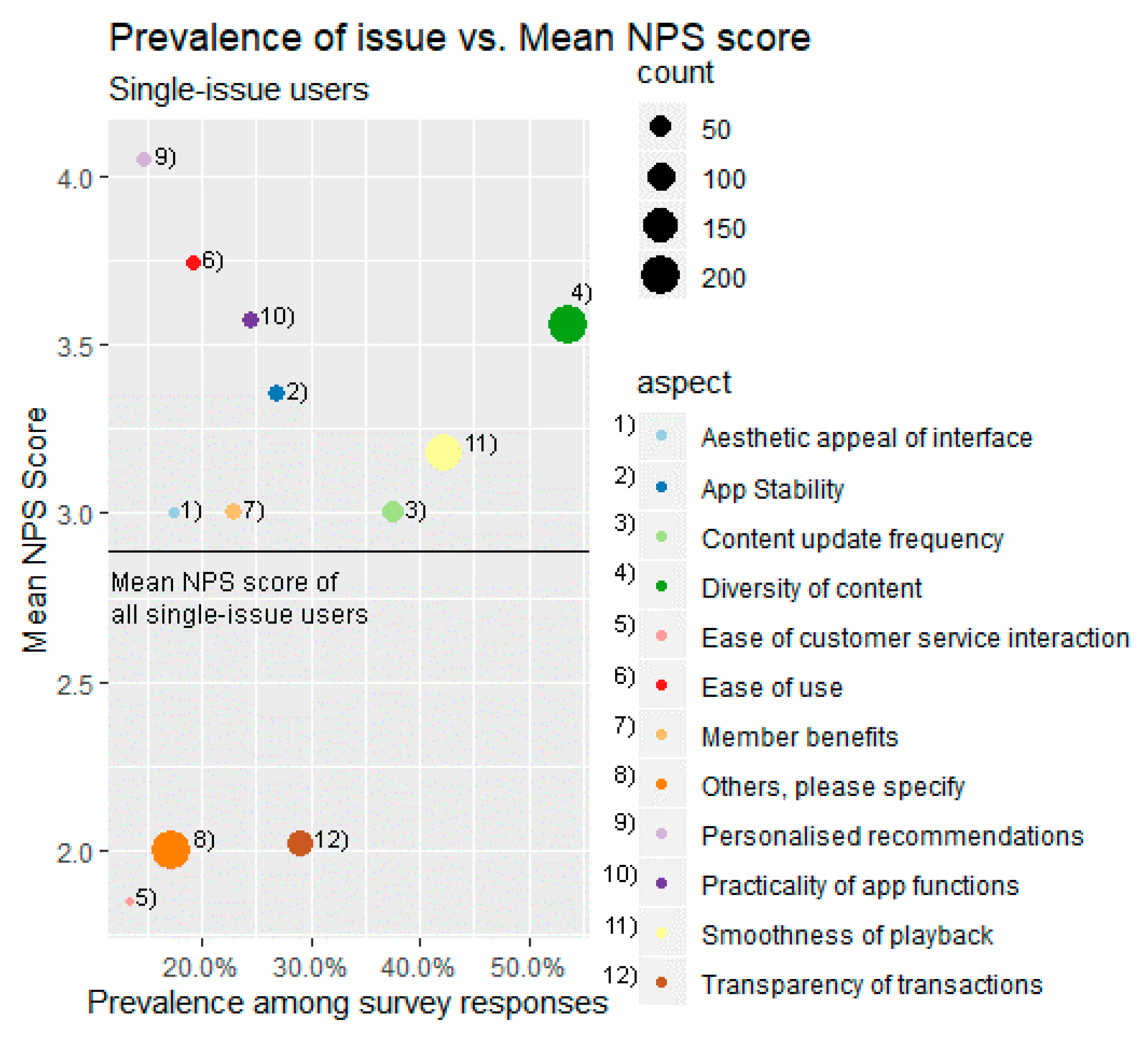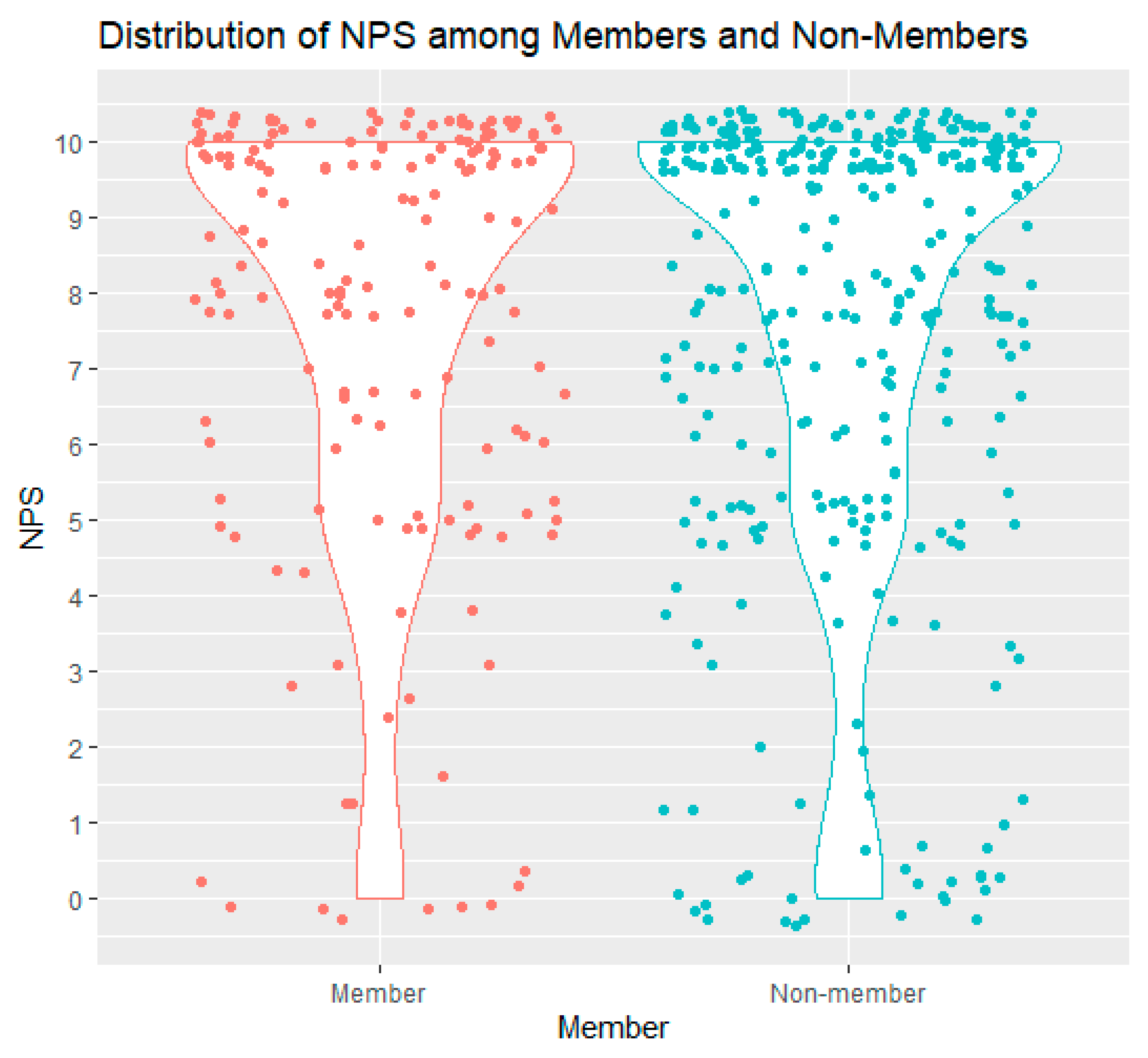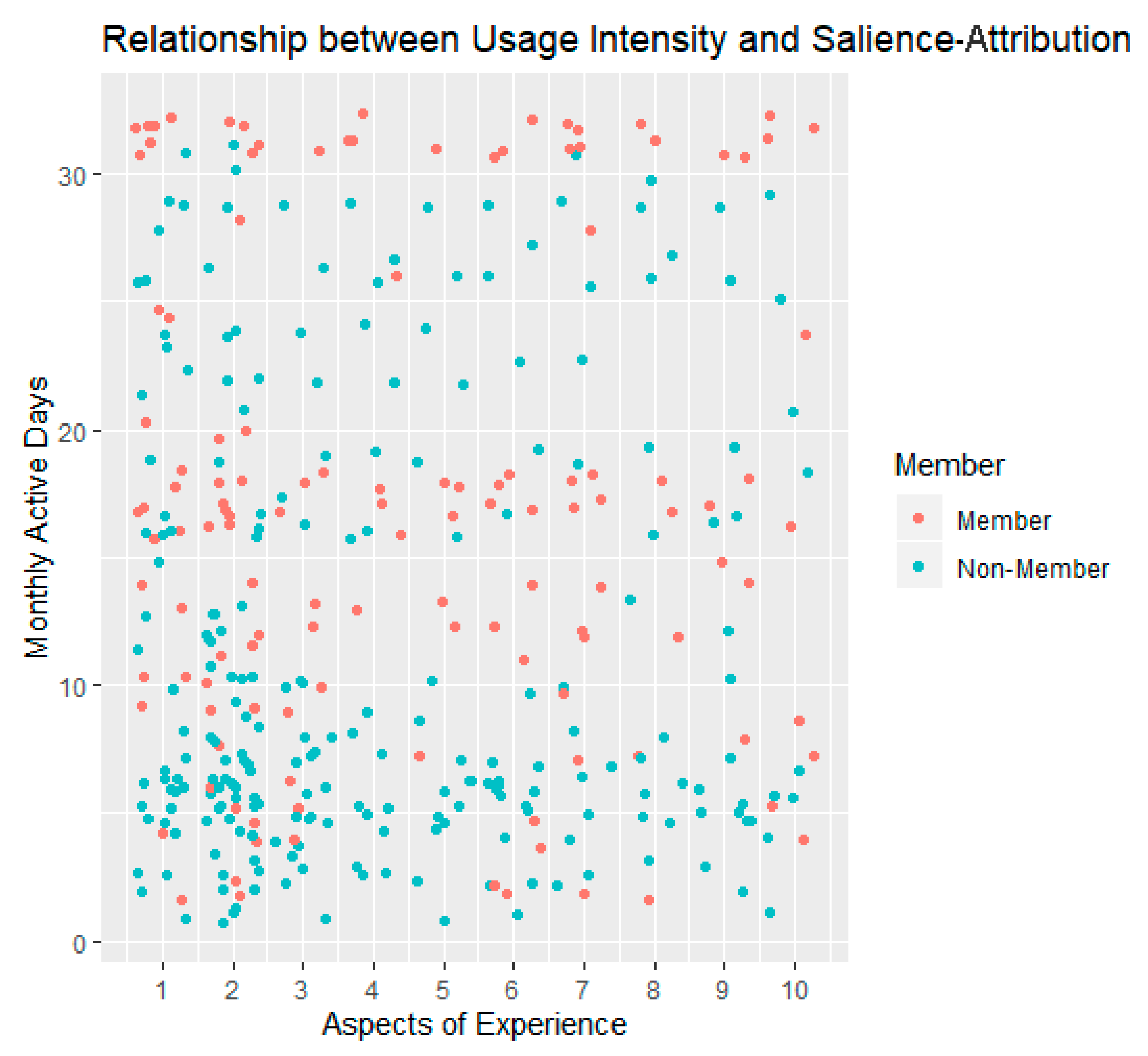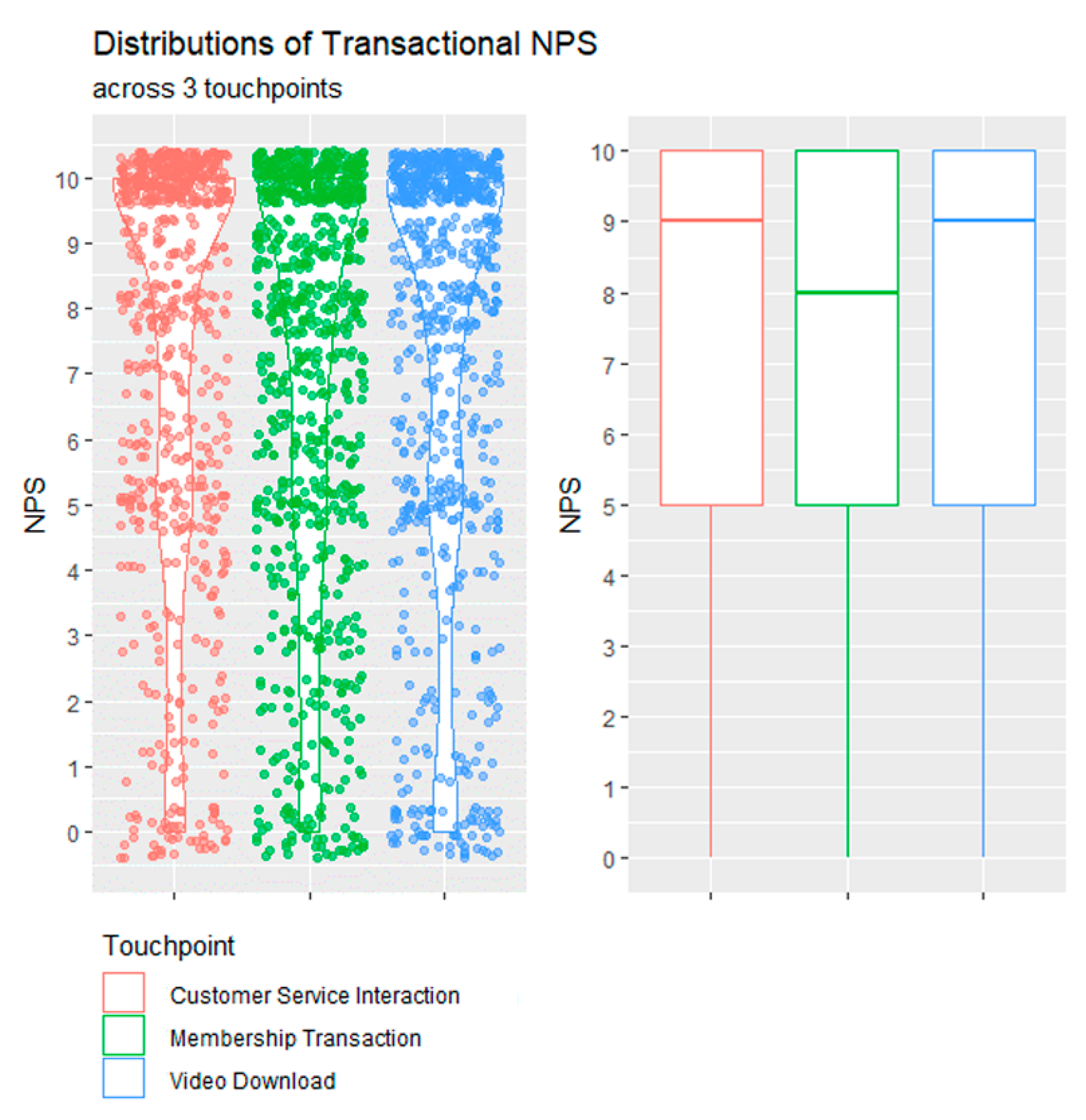A Combined Method of r-NPS and t-NPS Evaluations for Identification of Negative Triggers of Detractors’ Experience
Abstract
1. Introduction
2. Literature Review
3. Data and Methods
3.1. First Wave of Relationship-NPS Survey Data
3.2. Second Wave of r-NPS Survey Data with Usage Profiles
3.3. Transactional-NPS Survey
4. Analysis of Results
4.1. First-Wave Data
4.1.1. Comparing Aspects Driving Continuous NPS Outcome vs. Dichotomous Detraction Outcome
4.1.2. The Most Powerful Drivers of Negative Experience
4.2. Second-Wave Data
4.2.1. Relationship between Intensity of Usage and Overall Experience
4.2.2. Relationship between Membership Status and Overall Experience
4.2.3. The Relationship between Intensity of Usage and Salience-Attribution to Aspects of Experience
4.3. Transactional NPS Analysis
5. Discussion
6. Conclusions
Author Contributions
Funding
Conflicts of Interest
References
- Xue, M.; Xu, Z. Application of life cycle assessment on electronic waste management: A review. Environ. Manag. 2017, 59, 693–707. [Google Scholar] [CrossRef] [PubMed]
- Lee, S.; Geum, Y.; Lee, H.; Park, Y. Dynamic and multidimensional measurement of product-service system (PSS) sustainability: A triple bottom line (TBL)-based system dynamics approach. J. Clean. Prod. 2012, 32, 173–182. [Google Scholar] [CrossRef]
- Liu, X.; Jia, H.; Guo, C. Mobile application life cycle characterization via apple app store rank. Proc. Am. Soc. Inf. Sci. Technol. 2014, 51, 1–4. [Google Scholar]
- Localytics 23% of Users Abandon an App after One Use. 2016. Available online: http://info.localytics.com/blog/23-of-users-abandon-an-app-after-one-use (accessed on 29 September 2019).
- Feng, L.; Wei, W. An Empirical Study on User Experience Evaluation and Identification of Critical UX Issues. Sustainability 2019, 11, 2432. [Google Scholar] [CrossRef]
- Kujala, S.; Roto, V.; Väänänen-Vainio-Mattila, K.; Karapanos, E.; Sinnelä, A. UX Curve: A method for evaluating long-term user experience. Interact. Comput. 2011, 23, 473–483. [Google Scholar] [CrossRef]
- Hassenzahl, M.; Burmester, M.; Koller, F. AttrakDiff: A questionnaire to measure perceived hedonic and pragmatic quality. Mensch Comput. 2003, 57, 187–196. [Google Scholar]
- Feng, L.; Sun, B.; Wang, K.; Tsai, S.B. An empirical study on the design of digital content products from a big data perspective. Sustainability 2018, 10, 3092. [Google Scholar] [CrossRef]
- Finstad, K. The usability metric for user experience. Interact. Comput. 2010, 22, 323–327. [Google Scholar] [CrossRef]
- Brooke, J. SUS-A quick and dirty usability scale. Usability Eval. Ind. 1996, 189, 4–7. [Google Scholar]
- Fornell, C.; Johnson, M.D.; Anderson, E.W.; Cha, J.; Bryant, B.E. The American customer satisfaction index: Nature, purpose, and findings. J. Mark. 1996, 60, 7–18. [Google Scholar] [CrossRef]
- Forrester Research. CX Index. Forrester Research. 2019. Available online: https://go.forrester.com/analytics/cx-index/ (accessed on 16 October 2019).
- Reichheld, F.F. The one number you need to grow. Harv. Bus. Rev. 2004, 82, 133. [Google Scholar]
- Waugaman, A. From principle to practice: Implementing the Principles for Digital Development; Principles for Digital Development Working Group: Washington, DC, USA, 2016; Volume 4, p. 15. Available online: https://digitalprinciples.org/wp-content/uploads/From_Principle_to_Practice_v5.pdf (accessed on 16 October 2019).
- Huang, E.M.; Truong, K.N. Sustainably ours-Situated Sustainability for Mobile Phones. Interactions 2008, 15, 16–19. [Google Scholar] [CrossRef]
- Pan, Y.; Roedl, D.; Blevis, E.; Thomas, J. Fashion thinking: Fashion practices and sustainable interaction design. Int. J. Des. 2015, 9, 53–66. [Google Scholar]
- Chang, E.C.; Fan, X. More promoters and less detractors: Using generalized ordinal logistic regression to identify drivers of customer loyalty. Int. J. Mark. Stud. 2013, 5, 12. [Google Scholar] [CrossRef][Green Version]
- Lartey, F.M.; Hargiss, K.; Howard, C. Antecedents of Customer Satisfaction Affecting Broadband Loyalty: An Implementation of Servqual and NPS®. Int. J. Strateg. Inf. Technol. Appl. IJSITA 2015, 6, 26–41. [Google Scholar] [CrossRef][Green Version]
- Jeske, D.R.; Callanan, T.P.; Gui, L. Identification of Key Drivers of Net Promoter Score Using a Statistical Classification Model. Efficient Decision Support Systems: Practice and Challenges from Current to Future; InTech: Shanghai, China, 2011; pp. 145–162. [Google Scholar]
- Wilberforce, M.; Poll, S.; Langham, H.; Worden, A.; Challis, D. Measuring the patient experience in community mental health services for older people: A study of the Net Promoter Score using the Friends and Family Test in England. Int. J. Geriatr. Psychiatry 2019, 34, 31–37. [Google Scholar] [CrossRef]
- Reichheld, F. The Microeconomics of Customer Relationships. MIT Sloan Manag. Rev. 2006, 47, 73. [Google Scholar]
- Burnham, T.A.; Wong, J.A. Factors Influencing Successful Net Promoter Score Adoption by a Nonprofit Organization: A case study of the Boy Scouts of America. Int. Rev. Public Nonprofit Mark. 2018, 15, 475–495. [Google Scholar] [CrossRef]
- Jang, J.H.; Kim, S.W.; Lee, Y.S.; Kim, J. The effects of relationship benefit on relationship quality and store loyalty from convergence environments—NPS analysis and moderating effects. Electron. Commer. Res. 2013, 13, 291–315. [Google Scholar] [CrossRef]
- Haines-Gadd, M.; Chapman, J.; Lloyd, P.; Mason, J.; Aliakseyeu, D. Emotional Durability Design Nine—A Tool for Product Longevity. Sustainability 2018, 10, 1948. [Google Scholar] [CrossRef]
- Hassenzahl, M. The hedonic/pragmatic model of user experience. In Proceedings of the COST294-MAUSE Affiliated Workshop: Towards A UX Manifesto, Lancaster, UK, 3 September 2007; pp. 10–14. [Google Scholar]
- Brooks, L. Defining success: How to implement a successful net promoter program. J. Database Mark. Cust. Strategy Manag. 2009, 16, 185–188. [Google Scholar] [CrossRef][Green Version]
- McCarney, R.; Warner, J.; Iliffe, S.; Van Haselen, R.; Griffin, M.; Fisher, P. The Hawthorne Effect: A randomised, controlled trial. BMC Med. Res. Methodol. 2007, 7, 30. [Google Scholar] [CrossRef] [PubMed]
- Sauro, J.; Lewis, J.R. Quantifying the User Experience: Practical Statistics for User Research; Morgan Kaufmann: Burlington, MA, USA, 2016; p. 16. [Google Scholar]
- The Difference between Transactional and Relationship NPS (Updated). 2018. Available online: https://www.retently.com/blog/transactional-relationship-nps/ (accessed on 14 October 2019).
- Reis, H.T. Naturalistic Approaches to Studying Social Interaction; Jossey-Bass Inc.: San Francisco, CA, USA, 1983. [Google Scholar]
- Burmester, M.; Mast, M.; Jäger, K.; Homans, H. Valence method for formative evaluation of user experience. In Proceedings of the 8th ACM Conference on Designing Interactive Systems, Aarhus, Denmark, 16–20 August 2010; pp. 364–367. [Google Scholar]
- Froehlich, J.; Chen, M.Y.; Consolvo, S.; Harrison, B.; Landay, J.A. MyExperience: A system for in situ tracing and capturing of user feedback on mobile phones. In Proceedings of the 5th International Conference on Mobile Systems, Applications and Services, San Juan, Puerto Rico, 13 June 2007; pp. 57–70. [Google Scholar]
- Jetter, C.; Gerken, J. A simplified model of user experience for practical application. In Proceedings of the 2nd COST294-MAUSE International Open Workshop: User Experience-Towards A Unified View, NordiCHI 2006, Oslo, Norway, 14–18 October 2006; pp. 106–111. [Google Scholar]
- Charkraborty, A. The Aesthetic-Usability Effect: Why Beautiful-Looking Products are Preferred over Usable-But-not-Beautiful Ones. Medium. 2017. Available online: https://medium.com/@coffeeandjunk/design-psychology-aesthetic-usability-effect-494ed0f22571 (accessed on 6 November 2019).
- Redies, C. Combining universal beauty and cultural context in a unifying model of visual aesthetic experience. Front. Hum. Neurosci. 2015, 9, 218. [Google Scholar] [CrossRef] [PubMed]
- Raghavan, P. Raising the Bar on Transparency, Choice and Control in Digital Advertising. GoogleAds. 2019. Available online: https://www.blog.google/products/ads/transparency-choice-and-control-digital-advertising/ (accessed on 6 November 2019).
- Nielsen, J. Top 10 Mistakes in Web Design. Nielsen Norman Group. 2011. Available online: https://www.nngroup.com/articles/top-10-mistakes-web-design/ (accessed on 6 November 2019).
- Boeke, M. Using Transparency to Design for Trust. Synap. 2019. Available online: http://journeys.getsynap.com/using-transparency-to-design-for-trust (accessed on 6 November 2019).
- Castrounis, A. Why User Experience and Simplicity Drive Competitive Advantage. InnoArchitech. 2019. Available online: https://www.innoarchitech.com/blog/why-product-user-experience-design-simplicity-drive-competitive-advantage (accessed on 6 November 2019).
- Karapanos, E. User experience over time. In Modeling Users’ Experiences with Interactive Systems; Springer: Berlin/Heidelberg, Germany, 2013; pp. 57–83. [Google Scholar]






| Q1 | Q2 ** | Q3 ** | Q4 ** | |
|---|---|---|---|---|
| Question wording | On a scale of 0 to 10, how likely are you to recommend this platform to your friends and family? | Among the following aspects of experience, which one(s) would you most like to see improved? | Which aspect(s) of experience, if improved, would most likely make you recommend the product to your friends and family? | Which aspect(s) do you mention when recommending the product to your friends and family? |
| Question is distributed to: | ||||
| Promoters * | ● | ● | ||
| Passives * | ● | ● | ||
| Detractors * | ● | ● | ||
| Feature | Description |
|---|---|
| Sample size | 8522 |
| User distribution by NPS | 51.1% Promoters |
| 15.3% Passives | |
| 33.5% Detractors | |
| Number of users by NPS | 4356 Promoters |
| 1307 Passives | |
| 2859 Detractors | |
| NPS data summary, all users | Mean: 7.33 |
| Median: 9 | |
| Mode: 10 | |
| NPS data summary, detractors | Mean: 3.27 |
| Median: 4 | |
| Mode: 5 |
| Variable | Aspect of Experience | Types of Experience |
|---|---|---|
| Smoothness of playback | Pragmatic | |
| Diversity of content | Pragmatic | |
| App stability | Pragmatic | |
| Content update frequency | Pragmatic | |
| Practicality of app functions | Pragmatic | |
| Aesthetic appeal of interface | Hedonic | |
| Ease of use | Hedonic | |
| Transparency of transactions | Hedonic | |
| Member benefits | Pragmatic | |
| Ease of customer service interaction | Hedonic | |
| Personalized recommendations | Hedonic | |
| Others, please specify | N/A |
| Type of Experience | Variable | Aspect of Experience | Frequency of Appearance among All Responses | OLS Regression Coefficient on Continuous NPS Outcome (0–6) | Logistic Regression Coefficient on Dichotomous Detraction Outcome **** |
|---|---|---|---|---|---|
| Pragmatic | Smoothness of playback | 1,081 (42.1%) | 0.055 (−0.137, 0.246) | −0.030 (−0.205, 0.145) | |
| Pragmatic | Diversity of content | 1,373 (53.5%) | 0.237 ** (0.045, 0.430) | −0.209 ** (−0.385, −0.034) | |
| Pragmatic | App stability | 690 (26.9%) | 0.060 (−0.168, 0.287) | 0.013 (−0.195, 0.221) | |
| Pragmatic | Content update frequency | 964 (37.6%) | 0.292 ** (0.091, 0.493) | −0.172 * (−0.357, 0.012) | |
| Pragmatic | Practicality of app functions | 630 (24.6%) | −0.108 (−0.348, 0.131) | 0.037 (−0.182, 0.255) | |
| Hedonic | Aesthetic appeal of interface | 448 (17.5%) | −0.383 *** (−0.651, −0.115) | 0.279 ** (0.034, 0.523) | |
| Hedonic | Ease of use | 494 (19.3%) | 0.100 (−0.163, 0.363) | −0.101 (−0.342, 0.140) | |
| Hedonic | Transparency of transactions | 744 (29.0%) | −0.357 *** (−0.573, −0.140) | 0.182 * (−0.015, 0.380) | |
| Pragmatic | Member benefits | 587 (22.9%) | 0.216 * (−0.018, 0.450) | −0.192 * (−0.408, 0.024) | |
| Hedonic | Ease of customer service interaction | 346 (13.5%) | −0.406 *** (−0.715, −0.097) | 0.364 *** (0.083, 0.645) | |
| Hedonic | Personalized recommendations | 378 (14.7%) | 0.092 (−0.188, 0.372) | −0.116 (−0.373, 0.141) | |
| Customary | Others, please specify | 443 (17.3%) | −1.084 *** (−1.324, −0.844) | 0.885 *** (0.663, 1.107) |
| High Statistical Significance * | Low Statistical Significance | |
|---|---|---|
| High quantitative significance ** |
|
|
| Low quantitative significance | None |
|
| Feature | Distribution |
|---|---|
| NPS | 52.2% Promoters |
| 19.8% Passives | |
| 28.0% Detractors | |
| Membership status | 33.6% Member |
| 66.4% Non-member | |
| New user status | 9.0% New user * |
| 91.0% Old user | |
| Gender | 57.4% Male |
| 14.2% Female | |
| 28.4% Undeclared | |
| Province of origin | 17.0% Jiangsu |
| 15.2% Guangdong | |
| 6.2% Sichuan | |
| 6.2% Shanghai | |
| 52.4% Rest (Declared) | |
| 3.0% Undeclared | |
| Age group | 5.8% Under 25 years old |
| 8.6% 26–30 years old | |
| 8.4% 31–35 years old | |
| 10.0% 36–40 years old | |
| 10.6% 41–45 years old | |
| 10.4% 46–50 years old | |
| 7.4% 51–55 years old | |
| 6.0% Over 55 years old | |
| 32.8% Undeclared | |
| Monthly active days | 39.8% 0–10 days |
| 27.2% 11–20 days | |
| 32.8% 21–32 days |
| Label | Aspect of Experience User Would Like to See Improved |
|---|---|
| 1 | Smoothness of playback |
| 2 | Diversity of content |
| 3 | Practicality of app functions |
| 4 | Aesthetic appeal of interface |
| 5 | Ease of use |
| 6 | Transparency of transactions |
| 7 | Member benefits |
| 8 | Ease of customer service interaction |
| 9 | Personalized recommendations |
| 10 | Others, please specify |
| Label | Aspect of Experience User Would Like to See Improved |
|---|---|
| 1 | Smoothness of playback |
| 2 | Diversity of content |
| 3 | Practicality of app functions |
| 4 | Aesthetic appeal of interface |
| 5 | Ease of use |
| 6 | Transparency of transactions |
| 7 | Member benefits |
| 8 | Ease of customer service interaction |
| 9 | Personalized recommendations |
| 10 | Others, please specify |
| Hypothesis | Evidence | Support * |
|---|---|---|
| Hedonic aspects of user experience are significant in shaping the experience of detractors (Section 4.1) | Both OLS and logistic regressions showed the statistical and quantitative significance of the following hedonic aspects in determining the NPS outcome of detractors: “Aesthetic appeal of interface”, “Ease of customer service interaction”, and “Transparency of transactions” | ✓ |
| User experience improves proportionately to the volume of usage (Section 4.2.1) | An overall positive correlation between usage intensity and NPS outcome was found in both member and non-member sections | ✓ |
| There is a gap between paying and non-paying users in their user experience (Section 4.2.2) | Although members and non-members show a different pattern in salience attribution to aspects of experience that they find most needing improvement, no significant difference was found between the NPS distributions or NPS means between members and non-members | X |
| Several aspects of experience “Diversity of content”, “Member benefits” have a de-radicalizing effect on r-NPS outcome (Section 4.2.3) | There is a relatively thin concentration of radical detractors amid those who took issue with these two aspects. However, there is no evidence that concur with our speculation that users who took issues with these two aspects are more active mature users on average | † |
© 2020 by the authors. Licensee MDPI, Basel, Switzerland. This article is an open access article distributed under the terms and conditions of the Creative Commons Attribution (CC BY) license (http://creativecommons.org/licenses/by/4.0/).
Share and Cite
Feng, L.; Wei, W. A Combined Method of r-NPS and t-NPS Evaluations for Identification of Negative Triggers of Detractors’ Experience. Sustainability 2020, 12, 1652. https://doi.org/10.3390/su12041652
Feng L, Wei W. A Combined Method of r-NPS and t-NPS Evaluations for Identification of Negative Triggers of Detractors’ Experience. Sustainability. 2020; 12(4):1652. https://doi.org/10.3390/su12041652
Chicago/Turabian StyleFeng, Lin, and Wei Wei. 2020. "A Combined Method of r-NPS and t-NPS Evaluations for Identification of Negative Triggers of Detractors’ Experience" Sustainability 12, no. 4: 1652. https://doi.org/10.3390/su12041652
APA StyleFeng, L., & Wei, W. (2020). A Combined Method of r-NPS and t-NPS Evaluations for Identification of Negative Triggers of Detractors’ Experience. Sustainability, 12(4), 1652. https://doi.org/10.3390/su12041652




